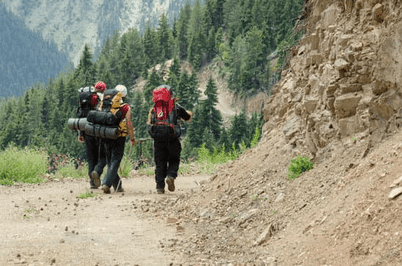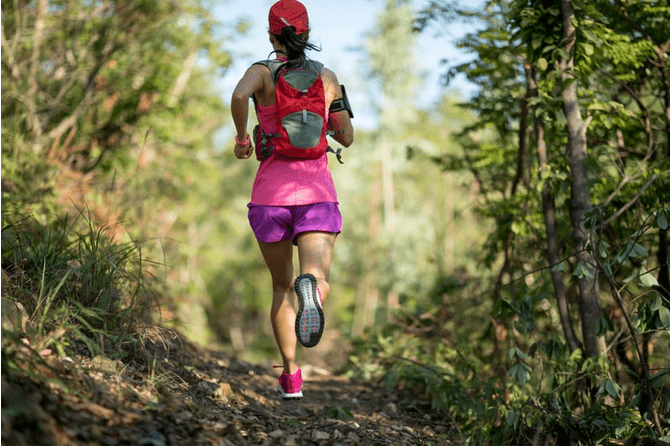Running Safety Tips:
Trail running is exciting, challenging, and peaceful. But, it's important to be prepared and safe. This article offers key tips to keep you safe and enjoy your trail running.
Key Takeaways
- Inform others of your trail running plans for increased safety and accountability
- Equip yourself with navigation tools and emergency communication devices
- Be aware of potential hazards, such as wildlife encounters and changing weather conditions
- Stay alert and focused to navigate the terrain with confidence
- Plan for the unexpected and pack essential gear to handle emergencies
Follow these safety tips to enjoy the outdoors safely. Letting others know your plans and packing the right gear are key. These steps will let you explore new trails with peace of mind and enjoy the excitement of running off-road.
Inform Others of Your Trail Running Plans
Before you start your trail running, tell someone about your plans. Share where you're going, when you'll be back, and a "panic time" when they should call for help if they don't hear from you. This step is key in an emergency, making sure someone knows where you are and can act fast. Always share this with a trusted friend or family member. It's a smart trail safety tip for solo trail runners.
Tell Someone Where You're Going and When You'll Be Back
Before you head out, let a trusted person know your trail running plans. Tell them where you're going, when you expect to return, and when they should act if you don't get back. This helps with your trail emergency preparedness and gives everyone peace of mind.
| Trail Running Safety Tip | Benefit |
|---|---|
| Inform someone of your trail running plans | Ensures someone knows your whereabouts and can respond quickly in an emergency |
| Share your route, expected return time, and "panic time" | Provides critical information for rescue efforts and increases your outdoor adventure preparedness |
| Choose a reliable friend or family member to notify | Guarantees your plans are communicated to a responsible party who can take action if needed |
Taking a few minutes to share your trail running plans boosts your trail safety and trail condition awareness. It's a key part of being responsible and sustainable trail runners.
Bring Navigation and Emergency Communication Devices
When you hit the trails, having the right gear is key. Carry a GPS device or a compass and map, especially in remote spots with no cell signal. These tools keep you on course and let you call for help if needed.
Mobile phones can show your location but might not work well in the mountains or when it's cold. Personal locator beacons (PLBs) send out a signal in emergencies to start a rescue. The ACR ResQ Link is a top pick.
Know How to Use Navigation Tools
Learn how to use your navigation devices before you go. This way, you can find your way and call for help if it's an emergency. Satellite Emergency Notification Devices (SENDs) let you text, track continuously, and connect to satellites.
The Delorme InReach SE lets you talk back and send complex messages. The SPOT Gen3 is smaller and lighter but only sends one-way messages. PLBs don't cost anything to use but don't let you talk back or track. SENDs cost more but offer better communication and tracking.
| Device | Communication | Tracking | Cost |
|---|---|---|---|
| Personal Locator Beacon (PLB) | One-way | No | No ongoing costs |
| Satellite Emergency Notification Device (SEND) | Two-way | Yes | Subscription required |
SENDs are great for making rescues more efficient with detailed messages. Choosing the right gear can ensure your runs stay safe and fun.

Safe Trail Running
Staying safe on trails means being prepared, aware, and making smart choices. It's important for both beginners and experienced runners. Always start with trails you know well and slowly move to harder ones as you get more skilled.
When running alone, pick trails that are often used to lower the risk. Pay attention to the weather and watch out for dangers. Know about the trail's rough spots, like rocks and roots, which can make you trip.
- Carry essential navigation and communication devices, such as a map, compass, or GPS device, to avoid getting lost.
- Wear appropriate clothing and footwear with good traction to ensure stability and comfort on the trails.
- Pack enough food, water, and layers to prepare for changing weather conditions and emergencies.
- Avoid the use of earbuds or headphones, as they can reduce your awareness of your surroundings and potential hazards.
- Be wildlife aware and carry EPA-approved bear spray for protection in areas with larger predators.
By staying alert, prepared, and making smart choices, you can have a safe and fun trail running experience. This way, you're also being responsible and safe outdoors.

Trail running is thrilling and rewarding but also riskier than running on roads. By focusing on your safety and using trail running techniques and trail condition awareness, you can run with confidence and enjoy your outdoor adventure.
Prepare for Changing Conditions and Emergencies
Trail running can change quickly, so being ready for different situations is key. Whether you're doing a tough ultra-marathon or a beautiful day hike, being alert and flexible is crucial. This ensures a safe and fun experience.
Check the Weather and Pack Accordingly
Always look at the weather forecast before you start your trail run. Weather can change a lot between the city and the wilderness, so it's important to have the right gear. Bring layers, rain gear, and sun protection for sudden weather shifts. Also, don't forget to pack important trail running gear like hydration packs, navigation tools, and first aid kits.
Be Aware of Potential Hazards
Trail runners need to know about the dangers they might face, like wildlife and tough terrain. Get to know the area and its risks, like steep slopes, slippery paths, or flood-prone areas. Knowing these risks helps you prepare for emergencies and lowers the risk of getting hurt.
Being ready for emergencies is crucial for trail runners. Carry a charged phone or a satellite device to call for help if needed. Know where emergency shelters, trailheads, and evacuation spots are on your route. Also, think about taking a wilderness first aid course to know how to handle injuries or emergencies in the wild.
By staying informed, packing the right gear, and knowing about wildlife and environmental issues, you can make your trail running safer and more fun.
Stay Alert and Focused
Staying alert and focused is key for safe trail running. Don't wear headphones that block out sounds around you. This can make it hard to hear dangers or other people on the trail. Instead, pay attention to your surroundings and listen for any signs of trouble.
Be ready to react fast to keep yourself safe. This way, you can handle unexpected situations quickly and safely.
The International Trail Running Association (ITRA) says more trail events are happening worldwide for trail running fans. This shows more people are getting into trail running. But, with more people joining, it's vital to keep safety in mind.
Trail runners should always be on the lookout, especially in places where bears and mountain lions might be around. This means you need to be ready for wildlife. Being alert helps you deal with any wildlife you might see.
Pay attention to where you step and the ground you're on. This can prevent injuries like ankle sprains, Achilles tendinitis, plantar fasciitis, and patellofemoral pain syndrome. By staying alert, you can run the trails safely and lower your injury risk.
Trail running is exciting and rewarding, but safety comes first. Keep your senses sharp, stay focused, and enjoy the trails. By following these safety tips, you'll have a great time on the trails without any worries.
Conclusion
Trail running is a great way to enjoy the outdoors, but safety comes first. This article has given you tips to stay safe on the trails. Now, you can run off-road with confidence.
It's important to tell others about your trail plans and carry the right gear. This includes navigation and communication tools. Being ready for different weather and knowing the dangers can also keep you safe.
For both new and experienced trail runners, following these safety tips is key. With the right gear, knowledge, and attitude, you can have exciting trail runs. You'll be able to enjoy the outdoors safely and responsibly.
FAQ
Q: What should I do before setting out on the trails?
A: Always tell someone your plans, like where you're going when you'll be back, and a "panic time" when they should call for help if they don't hear from you. This step is key in emergencies.
Q: What navigation and communication tools should I bring?
A: Carry a GPS, compass, and a paper map, especially in areas with no cell service. These tools help you stay on course and call for help if needed. Make sure you know how to use them before you go.
Q: How can I stay safe on the trails?
A: Start with trails you know, then move to harder ones as you get more experience. Choose busy trails when alone, and watch the weather and dangers. Being careful and alert is key for a safe run.
Q: How do I prepare for changing conditions and emergencies?
A: Look at the weather forecast and pack the right gear, like layers and protection from rain or sun. Know about dangers like wildlife and sudden weather changes. Learn about the area and risks to be ready and avoid emergencies.
Q: Why is it important to stay alert and focused?
A: Don't wear headphones that block out sounds around you. This can make it hard to hear dangers or other people on the trail. Stay aware of your surroundings and listen for risks. This helps you stay safe and react fast to surprises.
DISCLAIMER
This document is provided for general information purposes only and should not be relied upon as providing legal advice, technical, or specific operational guidance to the reader, whether as to the practices described in the document or the applicable legal requirements and regulations. {Save on Sneaks } expressly disclaims any responsibility for liability arising from or related to the use or misuse of any information in this document.




